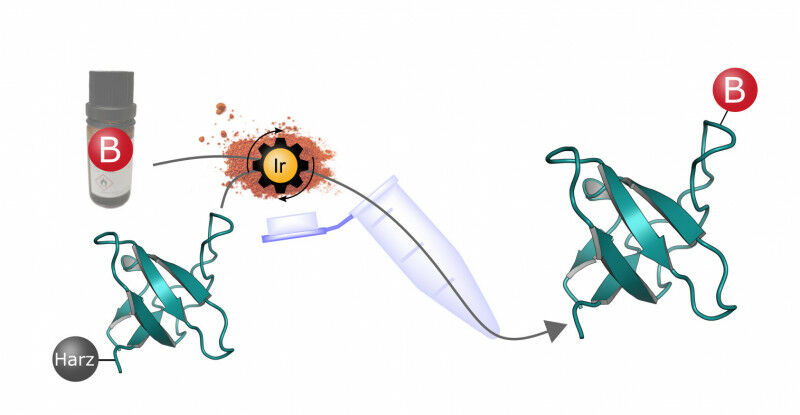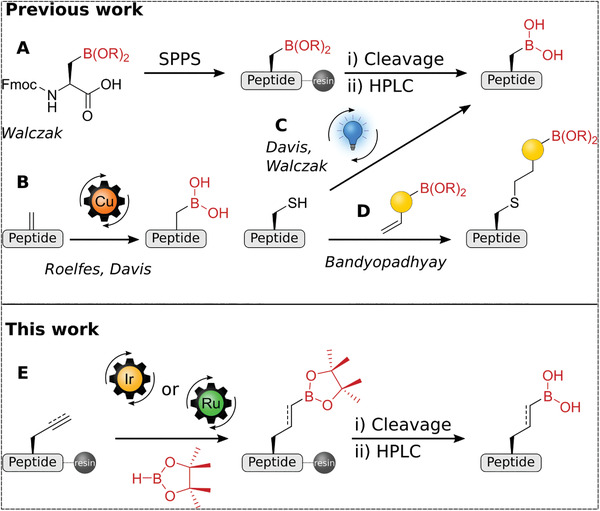博文
肽硼酸:免疫学的新前景
 精选
精选
||
肽硼酸:免疫学的新前景
诸平
Figure 0 Illustration, process for producing peptide boronic acids
据德国海德堡大学(Heidelberg University)2024年8月13日提供的消息,肽硼酸:免疫学的新前景(Peptide Boronic Acids: New Prospects for Immunology)。
海德堡大学的化学家和制药科学家开发了一种生产这些生物活性化合物的创新工艺(Chemists and pharmaceutical scientists at Heidelberg University develop an innovative process for producing these biologically active compounds)
一个尖端的化学过程是第一次使快速和容易地生产与硼酸修饰肽成为可能。它是由海德堡大学有机化学研究所和药物与分子生物技术研究所(Institute of Organic Chemistry and the Institute of Pharmacy and Molecular Biotechnology at Heidelberg University)的科学家开发的。作为这项工作的一部分,科学家们设法合成了大量不同的生物活性肽硼酸(biologically active peptide boronic acids),并研究了它们的性质。根据研究人员的说法,它们在合成免疫学(synthetic immunology)的年轻研究领域开辟了新的可能性,并且由于它们的特殊性质,可以主要用于免疫治疗(immunotherapy)。
肽类(Peptides)是由两个或两个以上的氨基酸连接在一起的聚合物,可以在生物体中任何有细胞的地方找到。它们在免疫系统中起着核心作用,因为它们传递重要的免疫识别标记。肽类的顺序和组成决定了什么被免疫系统识别为外源并引发免疫反应。由于这个原因,例如,治疗性或预防性免疫是使用肽类进行的,海德堡大学有机化学研究所和药物与分子生物技术研究所的博士候选人马吕斯·维尔纳(Marius Werner)解释说。研究人员之所以对硼酸感兴趣,是因为它们与免疫细胞或其他生物靶结构具有独特且尚未开发的相互作用。
在目前的研究中,研究人员通过氢化硼树脂结合的肽烯和肽炔(peptide alkenes and alkynes),生产出了配备硼酸的肽类物质。因此,它们具有一种特殊的化学结构,用科学家的话说,这种结构以前是不可能或非常难以获得的。海德堡大学有机化学研究所的初级教授(Junior Professor)弗兰齐斯卡·托马斯博士(Dr Franziska Thomas)解释说:“硼酸使得在肽类中引入进一步的化学修饰并实现许多变化变得非常容易。由于硼酸也与免疫细胞相互作用,因此这种结构元素增强的肽类可能被用于干预免疫系统。”弗兰齐斯卡·托马斯与药学和分子生物技术研究所的克里斯蒂安·克莱因(Christian Klein)一起领导了这项工作。
克里斯蒂安·克莱因教授说,虽然还有很长的路要走,但在新物质的帮助下,有可能诱导对肿瘤细胞的免疫反应,例如利用人体自身的机制摧毁肿瘤。另一个应用可能是体内活性物质的靶向释放。硼酸基团被用来作为肽的“锚”,允许它与作为运输介质的纳米颗粒结合。这位在药物化学(medicinal chemistry)领域进行研究的科学家说:“含有肽的颗粒可以被设计成被某些器官或某些细胞吸收的方式,特别是在免疫系统中,允许肽在其设计控制下产生任何类型的效果。”肽硼酸(Peptide boronic acids)也可以与小型植入物结合使用,这些植入物可以溶解在体内并释放出有效成分。
对这一新工艺的研究被纳入“合成免疫学”重点项目("Synthetic Immunology" spotlight project),作为海德堡大学“工程分子系统”旗舰计划("Engineering Molecular Systems" Flagship Initiative at Heidelberg University)的一部分,该计划由德国联邦政府和州政府的卓越战略(Excellence Strategy)资助。在这方面,将探讨潜在的应用领域。研究结果于2024年5月29日在《先进科学》(Advanced Science)杂志网站在线发表——Marius Werner, Julian Brinkhofer, Leon Hammermüller, Thomas M. Heim, Truc Lam Pham, Jonas F. Huber, Christian D. Klein, Franziska Thomas. Peptide Boronic Acids by Late-Stage Hydroboration on the Solid Phase. Advanced Science, 2024, 11(28): e2400640. DOI:10.1002/advs.202400640. ePub. 29 May 2024.https://doi.org/10.1002/advs.202400640
本研究得到了德国联邦教育和研究部{Bundesministerium für Bildung und Forschung (BMBF) Grant ID: ExU 6.1.16}、德国研究基金会(Deutsche Forschungsgemeinschaft Grant ID: 2082/1 390761711; Grant ID: 414261058)、德国化工基金(Fonds der Chemischen Industrie:Fonds der Chemischen Industrie for financial support through a Kekulé Fellowship)、德国马普学会(Max Planck Society / Max-Planck-Gesellschaft)以及德国巴登-符腾堡州科技部(Ministry of Science Baden-Württemberg / Ministerium für Wissenschaft, Forschung und Kunst Baden-Württemberg)的资助或支持。
上述介绍,仅供参考。欲了解更多信息,敬请注意浏览原文或者相关报道。
Organoboron compounds have a wide range of applications in numerous research fields, and metmhods to incorporate them in biomolecules are much sought after. Here, on‐resin chemical syntheses of aliphatic and vinylogous peptide boronic acids are presented by transition metal‐catalyzed late‐stage hydroboration of alkene and alkyne groups in peptides and peptoids, for example on allyl‐ and propargylglycine residues, using readily available chemicals. These methods yield peptide boronic acids with much shorter linkers than previously reported on‐resin methods. Furthermore, the methods are regio‐ and stereoselective, compatible with all canonical amino acid residues and can be applied to short, long, and in part even “difficult” peptide sequences. In a feasibility study, the protected peptide vinylboronic acids are further derivatized by the Petasis reaction using salicylaldehyde derivatives. The ability of the obtained peptide boronic acids to reversibly bind to carbohydrates is demonstrated in a catch‐release model experiment using a fluorescently labeled peptide boronic acid on cross‐linked dextran beads. In summary, this highlights the potential of the target compounds for drug discovery, glycan‐specific target recognition, controlled release, and diagnostics.
https://blog.sciencenet.cn/blog-212210-1446518.html
上一篇:[转载]评菲尔茨奖得主蒂莫西·高尔斯对√2不是有理数的证明

